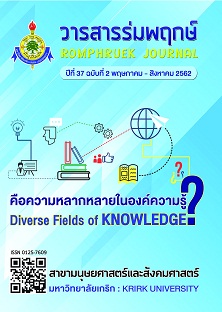Brand Equity Affecting the Purchasing Loyalty of Baba Clothing and Batik Sarong of Phuket Tourist Community Enterprise
Main Article Content
Abstract
This research aims to 1) analyze the opinion level and the relationship between brand equity and loyalty in the purchase of Baba clothing and the batik sarong of brand D's corner, and 2) investigate brand equity affected the purchase loyalty of brand D's corner. The research methodology was survey. The samples were 400 consumers who lived in Phuket and bought or used to buy brand D’s corner Baba clothing and Batik sarong brand. The research instrument was questionnaire. The data received were analyzed by descriptive statistics: frequency, percentage, means, standard deviation, Pearson’s correlation coefficient and multiple regression analysis. The results showed that both overall brand equity and overall loyalty were at the agreed level (= 4.34 and 4.32). The relationship between brand equity and loyalty in the purchase of brand D's corner found that the overall relationship had a high level (r = .796) of relevance and was in the same direction at Sig.01. Additionally, the brand equity had affected the purchase loyalty of brand D's corner. Multiple regression analysis in the standardized form was adjusted R2= 66.3%. This equation indicated that all three phrases of brand equity were able to forecast the variation on purchase loyalty of brand D's corner at 66.3 percent, the remaining of 33.7 percent which were due to other variables.
Article Details
Every article published in the Romphruek Journal of the Humanities and Social Sciences is the opinion and point of view of the authors. Thery're not the viewpoint of Krirk University or the editored department. Any part or all of the articles for pablication must be clearly cited.
References
กชพร สดเมือง. (2562). ยุทธศาสตร์การมีส่วนร่วมของผู้มีส่วนได้ส่วนเสียในการสร้างแบรนด์เพื่อสร้างความได้
เปรียบเชิงแข่งขันของสํานักงานคณะกรรมการการอาชีวศึกษาภาครัฐ. วารสารร่มพฤกษ์, 37(1), 95.
กัลยา วานิชย์บัญชา. (2549). สถิติสำหรับงานวิจัย. กรุงเทพฯ : โรงพิมพ์จุฬาลงกรณ์มหาวิทยาลัย.
กัลยา วานิชย์บัญชา. (2550). การใช้ SPSS for Windows ในการวิเคราะห์ข้อมูล. กรุงเทพฯ : บริษัทธรรมสาร จำกัด.
นงลักษณ์ ธีรพันธ์พิชัย. (2551). การโฆษณาที่มีผลต่อการรับรู้คุณค่าตราสินค้ากรณีศึกษาซุปไก่สกัดตราแบรนด์.
คณะบริหารธุรกิจ มหาวิทยาลัยบูรพา, ชลบุรี.
นภวรรณ คณานุรักษ์. (2561). คุณค่าตราสินค้าที่ส่งผลต่อความตั้งใจซื้อตราสินค้ารองเท้ากีฬาของผู้บริโภค
ในเขตกรุงเทพมหานคร. วารสารการจัดการสมัยใหม่, 16(1), 207.
นัทธีรา พุมมาพันธุ์. (2561). ผลกระทบการรับรู้คุณภาพของลูกค้าต่อความภักดีของลูกค้าโรงแรม 4 ดาว และ 5 ดาว.
วารสารร่มพฤกษ์, 37(1), 204-215.
บุญชม ศรีสะอาด. (2545). การวิจัยเบื้องต้น. กรุงเทพฯ : บริษัท สุวีริยาสาสน์ จำกัด.
เพ็ญประภา ภัทรานุกรม. (2560). วิจัยเพื่อท้องถิ่น : บทบาทมหาวิทยาลัยในการขับเคลื่อนการพัฒนา
ชุมชนอย่างยั่งยืน. ร่มพฤกษ์, 35(3), 141.
ภูเก็ตอินเด็กซ์. (2557). “บาบ๋า”วัฒนธรรมอันงดงามของชาวภูเก็ต. (15 พฤษภาคม 2561) สืบค้นจาก https://live.phuketindex.com.
ภูมิภัทร รัตนประภา. (2558). ความสัมพันธ์ระหว่างคุณค่าตราสินค้า ส่วนประสมทางการตลาด และความพึงพอใจ
ของผู้ใช้บริการบัตรเครดิตของธนาคารพาณิชย์ไทยที่มีอิทธิพลต่อกลยุทธ์การสร้างความภักดีต่อตราสินค้า.
วารสารปัญญาภิวัฒน์, 7(2), 43-44.
มหาวิทยาลัยราชภัฏภูเก็ต. (2560). ราชภัฏภูเก็ต เพิ่มมูลค่า “ผ้าปาเต๊ะเพ้นท์” หลอมรวมกระแสวัฒนธรรมและภูมิปัญญาชาวบ้าน.
(15 พฤษภาคม 2561) สืบค้นจาก http://www.pkru.ac.th/th/news/scoop/37-scoop-2/painting-pate-peranakan-batik-phuket-feb-2017.
ยินดี มโนสุทนทร. ประธานกลุ่มวิสาหกิจชุมชนผลิตภัณฑ์เพื่อการท่องเที่ยวโดยชุมชนเทศบาลนครภูเก็ต.
สัมภาษณ์, 18 มกราคม 2562.
ยุทธ ไกยวรรณ์. (2551). วิธีวิจัยทางธุรกิจ. กรุงเทพฯ : สำนักพิมพ์ศูนย์สื่อเสริมกรุงเทพ.
วิเชียร เกตุสิงห์. (2543). คู่มือการวิจัย : การวิจัยเชิงปฏิบัติ. กรุงเทพฯ : โรงพิมพ์และทำปกเจริญผล.
ศรีกัญญา มงคลศิริ. (2547). Brand management. กรุงเทพฯ : โรงพิมพ์เลิฟ แอนด์ ลิฟ.
ศิริวรรณ เสรีรัตน์ และ คณะ. (2546). การบริหารการตลาดยุคใหม่. กรงเทพฯ : บริษัทธรรมสาร จำกัด.
ศิริวรรณ เสรีรัตน์ และ คณะ. (2550). การจัดการและพฤติกรรมองค์การ. กรุงเทพฯ : บริษัท ธีระฟิล์มและไซเท็กซ์ จำกัด.
สิน พันธุ์พินิจ. (2549). เทคนิคการวิจัยทางสังคมศาสตร์. กรุงเทพฯ : บริษัท จูนพับบลิชชิง จำกัด.
สุชาติ ประสิทธิ์รัฐสินธุ์. (2543). ระเบียบวิธีการวิจัยทางสังคมศาสตร์. กรุงเทพฯ : บริษัท เฟื่องฟ้าพริ้นติ้ง จำกัด.
สุดารักษ์ วงษ์เจริญ. (2556). คุณค่าตราสินค้าส่งผลต่อความภักดีในการซื้อผลิตภัณฑ์เสริมอาหาร Blackmore.
คณะบริหารธุรกิจ มหาวิทยาลัยกรุงเทพ, กรุงเทพฯ.
สุพัตราวดี สถานเดิม. (2561). คุณค่าตราสินค้าและความพึงพอใจต่อความภักดีต่อตราสินค้าในสถาบันเทคโนโลยี
นิวเคลียร์แห่งชาติ องค์การมหาชน. วารสารสหวิทยาการวิจัย, 7(2), 58.
อรพรรณ ฐานะศิริพงศ์. (2555). กระแสวัฒนธรรมจีนบาบ๋า ในบริบทการท่องเที่ยวเชิงวัฒนธรรมศึกษาเฉพาะกรณีถนนถลาง
อำเภอเมือง จังหวัดภูเก็ต. คณะรัฐศาสตร์ จุฬาลงกรณ์มหาวิทยาลัย, กรุงเทพฯ.
อาระตี ตันมหาพราณ. (2552). การวัดคุณค่าตราสินค้าในกลุ่มธุรกิจธนาคารพาณิชย์.
คณะนิเทศศาสตร์จุฬาลงกรณ์มหาวิทยาลัย, กรุงเทพฯ.
Aaker, D. A. (1991). Managing brand equity : Capitalizing on the value of a brand name. NY : Free.
Backman, S. J. (1988). The utility of selected personal and marketing characteristics in explaining consumer loyalty to selected recreation serviced. College of Business Texas A and M University, Tx.
Helander M. G. and Khalid H. M. (2000). Modeling the customer in electronic commerce.
Applied Ergonomics, 31(6), 609-619.
Keller, K. L. (1993). Strategic brand management, building, measuring, and managing brand Equity.
NJ : Prentice Hall.
Kotler, P. & Keller, K. L. (2006). Marketing management. NJ : Pearson Education.
Kotler, P. & Keller, K. L. (2009). Marketing management. NJ : Prentice-Hall.
Peter, J. P., & Olson, J. C. (2008). Consumer behavior and marketing strategy. Boston : McGraw-Hill/Irwin.
Rovinelli, R. J., & Hambleton, R. K. (1977). On the use of content specialists in the assessment of criterion referenced test item validity. Dutch Journal of Educational Research, 2, 49-60.


